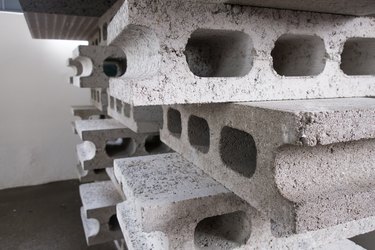
Molds can grow in many areas such as kitchen ceilings, underneath bathroom sinks and on carpet. However, many molds grow in areas much more difficult to see. Cinder block walls in garages or other areas may develop mold growth if moisture is present for a prolonged period of time. Removing mold is best accomplished with chlorine bleach or biocides. Avoid placing paint over mold on cinder blocks, as this may cause the paint to peel and become unsightly.
Identification of Mold Fungi
Video of the Day
The environment is full of mold fungi, which begin to grow after landing on moist surfaces in areas of high humidity. There are many types of mold fungi, but all must have moisture to grow and spread. Mold fungi is a common cause of allergic reactions in sensitive people. Prolonged exposure to molds can cause allergy symptoms such as sneezing, runny nose, cough, red eyes and skin rash. Mold spores are irritating to certain people and can cause adverse reactions whether the spores are alive or dead. It is important to remove mold and repair the source of moisture to prevent mold from returning to the same area.
Video of the Day
Diagnosing Mold In Your Blocks
Search for signs of mold on cinder block walls. Molds come in many colors such as white, gray, black or green and often have a distinctive musky odor. Cinder blocks in areas of high humidity such as garages and basements are likely to develop mold growth.
If you can see mold inside your cinder blocks, you must take time and effort to remove it. Unseen mold may be present. In this case, you'll have to rely upon your sense of smell to diagnose any existing cinder block mold. Your one single clue may be that nasty, dank musty odor in the area of concern.
Removal of Cinder Block Mold
It is not necessary to paint cinder blocks with expensive products to remove mold. The U.S. Environmental Protection Agency, or EPA, recommends that homeowners use liquid dish detergent and water to remove mold. A cleaning solution of chlorine bleach and water will also kill mold. Removing mold requires scrubbing it with cleansers, rinsing the mold away and drying with a soft cloth. During mold removal, homeowners should wear goggles, a mask, rubber gloves and long sleeves. After mold is removed from block walls, you can place paints containing biocides on your wall to prevent mold regrowth. Paints labeled mildew resistant can also help prevent the return of mold.
Cinder Block Mold Considerations
Avoid painting moldy cinder blocks or other hard surfaces without removing the mold as it will make paint chip and peel away. If you have mold on an area larger than 25 square feet, do not attempt to remove it yourself. Those who have asthma, bronchitis or allergies to mold should not be exposed to mold during removal. Homeowners who have known problems with mold should leave during removal. After removing mold, you should locate the source of moisture that caused mold to grow and remove it. Failure to repair water leaks will result in the return of mold.